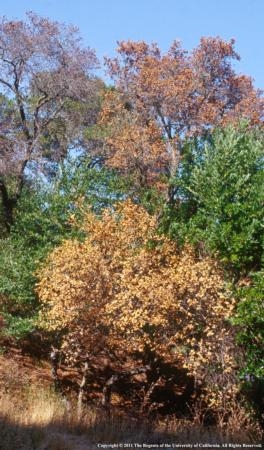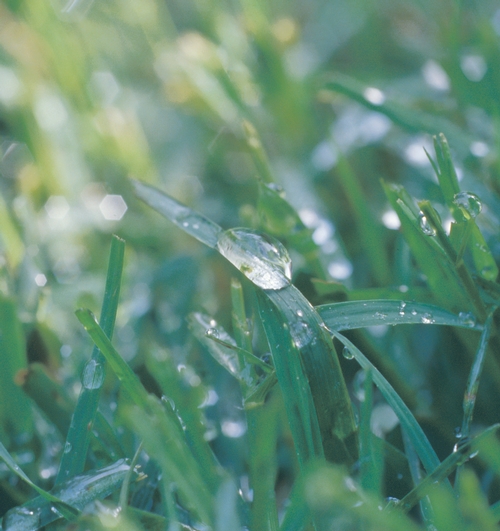UC Blogs
Coming Right at You
It's not often you see a monarch butterfly and a digger bee in the same photo. Such was the case on a recent visit to a lantana patch at a west...

Monarch butterfly nectaring lantana, while a digger bee, Anthophora urbana, heads toward it. (Photo by Kathy Keatley Garvey)
Threecornered Alfalfa Hopper Update
The threecornered alfalfa hopper is a green, wedge-shaped insect about the size of a Lygus bug. These leafhopper pests have piercing-sucking...
Sudden oak death expands in San Francisco Bay Area
Diseased trees were even found in Golden Gate Park, where there is no obvious source of the pathogen, such as nurseries or wildland.
"It's puzzling that we found it there because it's a totally urban environment, and I really didn't expect it. It shows how complicated and adaptable this organism is," said Matteo Garbelotto, UC Cooperative Extension specialist in the Department of Environmental Science, Policy and Management at UC Berkeley. "The area doesn't have a lot of oaks, so I'm not worried about oaks there, but I'm worried about other plants being infected and, of course, people carrying it on their shoes."
UC Cooperative Extension Advisors Help Develop the National Standard for Landscape Water Needs
The American Society of Agriculture and Biological Engineers (ASABE) has appointed Dennis Pittenger, area environmental horticulturist for Southern California, and David Shaw, farm advisor in San Diego County, to serve on its panel of experts to develop a national standard for determining the water needs or urban landscapes. Once developed, the standardized procedure will be the national, science-based method employed by landscape management professionals, water agencies and local jurisdictions that need to meet or implement landscape water conservation mandates.
ASABE selected Pittenger and Shaw based on their extensive research on estimating water needs of non-turf landscape plants and their history of providing education programs for green industry professionals who manage landscape irrigation.
"The past and current approaches have not been reliable in the numbers they produce, and they give users a false sense of precision while failing to achieve the intended conservation of water. The new method will be simple to use and based on 20 years of research findings," said Pittenger. "It is a great opportunity to see research-based information play an important role in public policy and standards adopted by the industry," he added.
ASABE is a 9,000-member international scientific and educational organization dedicated to the advancement of engineering in agriculture, food and biological systems. It is recognized worldwide as a standards developing organization with more than 240 standards in current publication.
For more information on the development of the standard procedure for landscape water needs, please contact Dennis Pittenger at (951) 827-3320, dennis.pittenger@ucr.edu.
For information on UC Cooperative Extension's offerings in environmental horticulture, please visit UCCE-LA's website.
As part of the University of California, Cooperative Extension was established in 1914 to connect local communities to their state's land grant university. An office in each county in California responds to the changing needs of its local populations, designing and carrying out research-based programs in the areas of food, health, agriculture, horticulture and the environment.
Castor oil makes a comeback
Stephen Kaffka, UC Cooperative Extension specialist in the Department of Plant Sciences at UC Davis, is field testing a variety of potential biofuel crops in California, including castor, wrote Harry Cline in Western Farm Press.
Among the possibilities are canola, amelina, meadowfoam, sugar beets, sweet sorghum, sugar cane and switchgrass. Castor, however, is the only on with a yellow "Do Not Cross" tape circling the experimental plots. The warning stems from the fact that castor beans contain the potent toxin ricin. Ricin is a considered both a chemical and biological weapon, according to the article.
Cline wrote that researchers at Texas AgriLife Extension found castor to be drought and salt tolerant. Kaffka has trials in the San Joaquin Valley, Salinas, Imperial Valley and at UC Davis to verify the Texas work.
Kaffka told a field day audience at the West Side Research and Extension Center in Five Points that the oil crop is worth $3,000 to $5,000 per ton, thus the renewed interest in it as a crop with an oil market today in the U.S. and a future market for biofuel.




